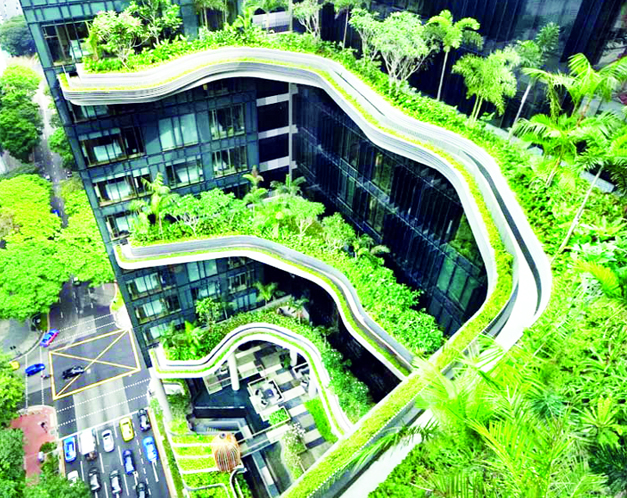Swarn Veer Singh Jaral
Green roof technology is progressively being used to increase the energy and environmental efficiency of buildings and appears to be an attractive option for sustainable design as it may offer specific benefits to the building, especially at the energy level. The thermal comfort, which shows the satisfaction of the inhabitants, is one of the key factors in the energy usage in buildings. Energy savings, however, are one of the benefits that a greenery scheme can give a house. Roofs add about 20-25% of the overall metropolitan environment, and they may have a huge effect on the size of the structure and the atmosphere. Green roofing is the most widespread type of greenery seen in European, North American and some tropical Asian countries. Germany is known as the global leader in green roofing technology growth. Nevertheless, typically dynamic models implemented for the simulation of green roof efficiency involve the awareness of certain parameters, which are frequently challenging to predict, in order to better describe the thermal interactions with the exterior world. However, the explanation of the thermal behavior of green roofs is very complicated because it relies on several variables and is dependent on nuanced phenomena. Vacant spaces, such as unplanted, unmanaged or poorly accessible green roofs, may play a vital role in preserving urban biodiversity. The advantages of green roofs are widely discussed in literature: insulation and cooling impacts, elimination of urban heat islands, sun absorption, sound and noise absorption, monitoring and maintenance of rainfall and drainage of water are only a couple. However, there is a lack of requirements at European level for the determination of several of these advantages and in particular, for the measurement of the thermal resistance of the increasing media and the drainage layer. Green roofs will, however, improve energy savings in winter and a thorough review of their efficiency in various climates is strongly recommended. Many researchers used various types of insulation products, the drainage method, planting and soil selection with appropriate layer thickness could be more oriented. The insulation layer is used to reduce heat transfer rates whilst the drainage device is very useful for removing the water in a systematic manner without damaging the concrete surface.
Benefits:
The main purpose of this article is to justify the value of going green which will assist decision making process. It is even more valuable under the context of Global Financial Crisis where clients have comparatively smaller finance capacity and financial institutions are more conservative in terms of lending decision. A common approach adopted in existing studies is to compare the characteristics of green buildings to those of conventional buildings such as energy efficiency, water efficiency, indoor environmental quality, thermal comfort, health and productivity. There are several advantages to using green construction methods, which is well acknowledged. Green buildings, through utilizing sustainable land use, contribute to enhancing urban biodiversity and preserving the environment. Sustainable building design must include measures to reduce waste from development and demolition. When it comes to reused and recycled materials in new construction, the recycling rate must be over 90% in order to reduce the evident environmental effects of construction and demolition waste.
Green buildings often perform better than traditional structures, as seen by their increased energy efficiency, reduced water usage, and reduced carbon emissions. Improved building performance is also linked to cost savings, especially when viewed from a life cycle viewpoint. The operation cost is reduced as a consequence. Economist claims that green buildings may save energy use by 30% compared to conventional ones. According to a research commissioned by the General Services Administration, green buildings outperform their conventional equivalents in terms of energy efficiency, water efficiency, and cost efficiency when it comes to upkeep. Some academics asserted that there are other advantages to green building that are not directly connected to costs. This research gave special attention to the positive effects of green buildings on people. This occurs as a result of the length of time people spend inside buildings. Thermal comfort, which is a complex dynamic of temperature and humidity, is intimately connected to the happiness of building users. Researchers have given this substantial consideration when modelling and calculating the thermal comfort level in green buildings in comparison to conventional structures. The desired range of room temperature might then be proposed. Adaptive thermal comfort may also be attributed to psychological, physiological, cultural and behavioral variables.
(The author is Ph.D Scholar in Mechanical Engineering)
Trending Now
E-Paper


